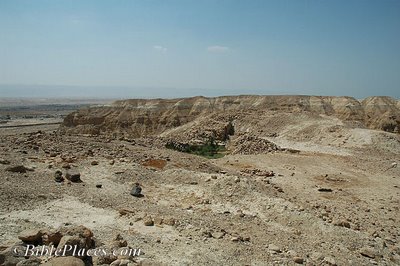I’ve been reading for a few weeks about new excavations by Steve Collins of a site that he thinks is biblical Sodom. You can read a typical report in the El Defensor Chieftain (also here and here), which doesn’t tell you much besides the site’s name and the excavator’s enthusiasm. The proposed site is Tell el-Hammam, which didn’t ring any bells. So I grabbed my copy of the best place to start for research on biblical sites in Jordan: “East of the Jordan:” Territories and Sites of the Hebrew Scriptures, by Burton MacDonald (ASOR, 2000). It says that the site is located on the northeastern region of the Dead Sea, in what is known biblically as the “plains of Moab.” Bells went off, as I know from previous study that of the three possible regions for the location of Sodom and Gomorrah based on all of the Scriptural evidence (northeast, southeast, under the Dead Sea), the least likely is the northern theory. The second problem is not insurmountable, if the excavators can find evidence of occupation from a different period that has been found already. I’ll quote MacDonald in full here, as it may be useful in the months/years to come as the Hammam excavation moves forward.
Tall al-Hammam appears to be a very large and strongly built Iron Age I-II fortess (sic) completely enclosed by a strong outer fortification wall (Glueck 1951: 379). The East Jordan Valley Survey reports Iron I-II sherds as dominant at the site (Yassine, Sauer, and Ibrahim 1988: 192, 197-98). Prag’s 1990 work at the site indicates that relative to the northeast tell at Hammam ‘the most prominent ruins are probably of the Iron Age II and Persian periods, when it appears to have been strongly fortified. These remains were recorded in some detail by Glueck, who dated them to the Iron Age 1 and 2 periods’ (1991: 60). Tall al-Hammam is a good, though not certain, candidate for the location of Abel-shittim (MacDonald 2000: 90).
Perhaps then Collins will have one biblical site (Abel-shittim) if not the other (Sodom).
What does the team need to find in order for this site to potentially be identified with Sodom? A destruction layer in EBIV/MBI/Intermediate Bronze (2300-2000 B.C.). The Iron Age mentioned above is dated roughly 1200-600 B.C.
